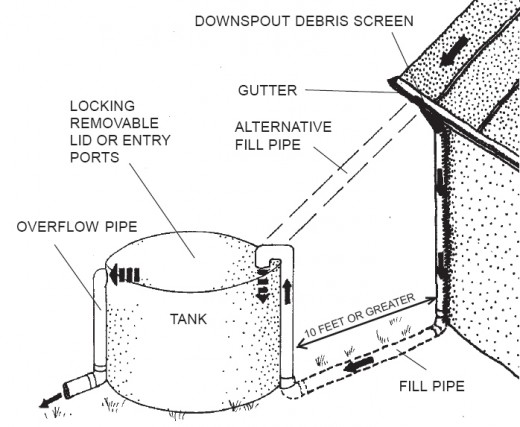How to Estimate Rainfall Runoff Volumes for Water Harvesting

Water harvesting is a great way to help curtail your dependence on municipal water to irrigate your landscaping. If you are thinking about constructing some swales, micro-basins, or even rain barrels to capture rainfall, it would be wise to estimate the anticipated amount of rainfall that you would expect to see at your location. This will help you avoid over-sizing (or under-sizing) your water harvesting devices by maximizing the amount of water that can be captured to the greatest practicable extent.
Please keep in mind that the methods presented in this article have been generalized. Many jurisdictions around the country have developed their own specific methods to estimate runoff volumes for water harvesting designs. In addition to this, the methods presented here may not be applicable to all situations. If you intend to use it to obtain a permit, please check with your local jurisdiction to ensure its applicability.
Concepts of Runoff Volume Estimation
The overarching principles of computing runoff volumes are essentially the same everywhere you go. Runoff volumes are dependent on a number of factors including but not limited to: rainfall depth, drainage area, impervious cover, antecedent soil moisture, soil texture, vegetative cover, evaporation rates, and even temperature and humidity. For the purposes of water harvesting, you won’t really be concerned with many of these items. A simplified approach to estimating runoff volumes will be sufficient for most people's water harvesting needs.
In addition to this, the majority of runoff estimation methods rely on a probabilistic (e.g. 100-yr storms, etc) approach to design. While a water harvesting design can certainly be performed using this approach, they tend to require more computational effort and research to complete properly. In an effort to reach more people, I chose to discuss a simplified approach in this article. Perhaps I will revisit this in a future discussion.
The Runoff Volume Equation
The simplified (and generalized) formula for calculating runoff volumes for small drainage areas (like your property or rooftop) is:

Where V is the water volume in cubic feet, C is the dimensionless runoff coefficient, P is the Precipitation depth in inches, and A is the catchment or drainage area in square feet. If you want to convert the amount of water into gallons, simply multiply the result by 7.48.

Precipitation (P)
Of these variables, the most difficult one to obtain will likely be the precipitation depth value. The precipitation value that you will need to use in your design will depend on a number of factors such your geographic location, what you are designing, and what you want to use the harvested water for. There are many ways to approach this issue, but probably the simplest will be to determine the average annual amount of precipitation that occurs at your location and divide it by the number of days that it actually rains. This will give you an estimate of the amount of rainfall you will receive on an average rainy day.
For example, Dallas, Texas has an annual average precipitation of 34.7 inches. It also rains for on approximately 78 days out of the year there. This means that on an average rainy day, Dallas gets 0.44 inches of rain.
Catchment Area (A)
The catchment area (or drainage area) is the area of land that will drain toward a particular area when it is rained on. If you are designing a small basin on your property, the catchment area could be a portion of your property. If you are designing a rain barrel, it could be just the area of your roof. All areas should be measured as a horizontal projection. It must be noted that no more rain falls on a slanted roof than a flat one.
Runoff Coefficient (C)
The runoff coefficient to be used in water harvesting computations will be dependent on the type of land cover that the catchment area consists off. The reason that this coefficient is important is because it de-rates the runoff volume to automatically account for things like soil infiltration and incipient surface retention. In any given situation, there is never a 100% transfer of water volume from rainfall to runoff, even on a completely impervious surface. The table below summarizes some of the most common runoff coefficients that are used.
Type of Ground Cover
| Runoff Coefficient
|
|---|---|
Asphalt Driveway
| 0.85 - 0.95
|
Concrete Driveway
| 0.90 - 0.95
|
Brick Driveway
| 0.70 - 0.85
|
Gravel Driveway
| 0.65 - 0.80
|
Pitched Rooftops
| 0.85 - 0.95
|
Flat Rooftops
| 0.75 - 0.95
|
Flat Lawn over Sand (<2% Slope)
| 0.05 - 0.10
|
Flat Lawn over Clay (<2% Slope)
| 0.01 - 0.02
|
Sloped Lawn over Sand (2-7% Slope)
| 0.10 - 0.15
|
Sloped Lawn over Clay (2-7% Slope)
| 0.20 - 0.25
|
Natural land with Sparse Vegetation
| 0.30 - 0.50
|
Natural land with Dense Vegetation
| 0.20 - 0.40
|
Forests
| 0.05 - 0.25
|
Meadows & Pasture Lands
| 0.10 - 0.45
|
Cultivated Land
| 0.10 - 0.40
|
Unimproved Vacant Land
| 0.10 - 0.30
|
When your catchment area is composed of multiple land types, you need to compute an average runoff coefficient to use in the runoff volume formula.
Example Problem
John wants to design some rain barrels that capture runoff from the roof of his 2,000 sqft home located in Dallas, Texas. The home is a simple rectangular structure (40ft by 50ft) with a standard pitched roof design with 2ft eaves. The edges of the roof have gutters that direct water to two downspouts (one either side of the home). How big should John make each of his rain barrels assuming he intends capture and use as much water as is practicable?
Determine Precipitation Depth
The annual rainfall in Dallas is 34.7inches. It rains for 78 days out of the year.
Therefore, the typical rainy day has 0.44inches of rain.
Determine Runoff Coefficient
From the table, a rooftop has a runoff coefficient of 0.85 to 0.95. Use 0.90
Determine Catchment Area
The dimensions of the home are 40ft by 50ft. Since the roof extends 2 feet beyond the edge of the home, the rooftop dimensions are 44ft by 54ft. This makes the rooftop area equal to 2,376 sqft. Since the roof has a standard pitched design, only half of the roof will drain to each side. Therefore, the catchment area for one of the rain barrels is 1,188 sqft.
Volume Computation
The runoff volume is equal to CPA/12 = (0.90) × (0.44 inches) × (1,188 ft2) / 12 = 39.2 ft3
Convert to volume to gallons. 39.2 ft3 × 7.48 gal/ft3 = 293 gallons. Use a 300 gallon barrel.
Based on this information, John would be able to capture most of the rainfall occurring from an average day’s rain using two 300 gallon barrels placed on either side of his home.









